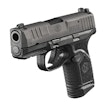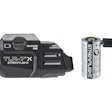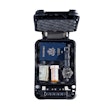Today's police handgun market abounds with full-sized, medium-sized, and compact .45 ACP pistols. But until recently the designers of these weapons all labored under a seemingly insurmountable constraint: size.
When you build a pistol for a cartridge whose bullet approaches one-half inch in diameter and whose overall length can be as much as 1.275 inches from nose to primer, even the most sub-compact pistol in .45 ACP is going to be cursed with a generously dimensioned grip.
Grip size is not an issue for officers with large hands. But if you have small hands, grip size can be a critical concern when selecting a duty, off-duty, or backup pistol. This is why officers with smaller hands have generally favored 9mm and .40 S&W caliber pistols. Still, some of these officers wanted .45 ACP pistols for more punch and sacrificed capacity to get it.
A New Cartridge
For quite some time, Glock has offered several pistols chambered for the .45 ACP round. Then a couple of years ago when the company queried its customers as to the type of pistol they would like to see next manufactured by Glock, the consensus was "...a .45 the size of the G17/22."
The firearms designers at Glock scratched their heads. Then they went to work. The solution to this conundrum turned out to be quite simple: if the .45 ACP won't fit the pistol, make a .45 caliber cartridge that will.
Glock did just that. In 2003, in cooperation with Speer, Glock introduced a proprietary cartridge that would fit into a G17/22 sized pistol, the .45 Glock Auto Pistol (G.A.P.). The .45 G.A.P.'s case measures 0.775 inches in length, but its overall length is 1.070 inches, slightly shorter than the 9mm Parabellum.
It is loaded to the same maximum average pressures as the .45 ACP +P (23,000 psi), which is less than that of the 9mm Parabellum and .40 S&W (35,000 psi). This allows the .45 G.A.P. to fit a wide range of compact and sub-compact sized pistols. For officers who desire a pistol with the performance of the .45 ACP, but who have smaller hands, the .45 G.A.P. is a wish come true.
Glock's first .45 G.A.P. pistol, the G37, features a grip frame the same size as the G17/22 pistols. But so as to accommodate the larger cartridge, the width, height and mass of the slide were increased slightly. It's been a big success.
That's why Glock recently released two new models in the .45 G.A.P. line, the compact G38 and sub-compact G39. Except for their larger slides, these guns approximate the dimensions of the G19/22/32 and G26/25/33 pistols, and were designed specifically for concealed carry by plainclothes and off-duty police officers.
I have often been criticized for saying, "A Glock, is a Glock, is a ..." Well you get my drift. But this should in no way be construed as a slam against Glock. One of the Glock's biggest advantages as a service pistol is that, regardless of which model you choose, the operating drill, method of field stripping, location of controls, etc., are exactly the same. An officer can pick up any Glock pistol in any caliber and operate it as easily as any other Glock.
There's another reason that Glock pistols are so popular with police agencies: Glock offers each officer a pistol for each need that he or she may have. On patrol or in day-to-day operations, the officer can carry a full-size duty weapon. Off-duty, undercover, or as a backup weapon, the officer can carry a compact or sub-compact that is a scaled-down version of his or her duty weapon, that works the exact same way, and that accepts the same magazines.
This makes it very easy for an officer to transition from his or her duty gun to a backup or concealed pistol. It's a great advantage of the Glock line. Hence, the .45 G.A.P. line now includes the full-size G37, the compact G38, and the sub-compact G39.[PAGEBREAK]
Testing and Evaluation
Glock provided me with samples of the G38 and G39 to evaluate for Police. Out of curiosity I got out my calipers and compared their slides to those of the .40 caliber G22 and .45 caliber G21 pistols. The slides on the compact and sub-compact .45 G.A.P. G38 and G39 are slightly larger than the slide on the .40 S&W G22 and slightly smaller than the slide on the .45 ACP.
I decided that that was enough math. It was time to take these little .45s to the range. I called up my friend Rusty Rawsen, and we ran the G38 and G39 through their paces, firing a variety of .45 G.A.P. ammo from Speer, Federal, CCI, and Remington.
The mundane task of accuracy testing was accomplished by firing several five-shot groups with each pistol from a rest. Our target was set at 15 yards. We also took this opportunity to chronograph each load. The results of this testing are displayed on the chart below.
While Rusty belted on a Gould & Goodrich Yaqui Belt slide holster and mag pouch, I trekked out and set up a pair of targets. He then ran each Glock through the following drills:
- Five yards-Draw pistol, fire three rounds on each target, firing unsupported (one-handed).
- Seven yards-Draw pistol and double tap each target. Perform a combat reload and repeat.
- Ten yards- Draw pistol and double tap each target. Perform a combat reload and repeat.
- Fifteen yards-Draw pistol and fire six rounds on each target, slow fire. Reload as necessary.
Except for a few of the rounds fired from 15 yards, Rusty put the vast majority of his shots into the higher scoring zones of the target. While Rusty found the out-of-the-box triggers a bit stiff, he could find nothing else to pass a negative judgment on. We ran approximately 200 rounds through each pistol during our evaluation and there was not a single failure to feed, fire, or eject.
Shooting Impressions
I thought it would be best if I let Rusty describe how the new Glocks performed. He really likes Glocks, and he has small hands. So he's part of the target market for the G38 and G39 compacts.
"I have owned and fired every model of Glock pistols since their introduction into the United States in mid 1986," Rusty says. "The first time I wrapped my shooting hand around a G17, in 9mm, I knew it was going to be my semi auto pistol of choice. Every single Glock model that I have shot to date has shot 2-inch groups or less, at 25 yards, right out of the box.
"The new G38 and G39 in .45 G.A.P. were no exception. When I got the chance to put these guns through their paces, I grabbed the G38 first and proceeded to fire several different bullet weights and designs from four different manufacturers. I shot 185-grain, 200-grain, and 230-grain rounds through both pistols, and they both produced hits at point of aim from as close as five yards, all the way out to 25 yards. Keep in mind, the .45 G.A.P. is a pretty 'peppy' round, but both pistols performed flawlessly, and are very controllable."
Rusty believes that the G38 and G39 are well designed for shooters with small hands. "Female shooters, or those with small hands, wouldn't have any trouble adapting to either of these two new pistols," he says.
"For some reason, I could shoot the G39 a little more accurately than the G38, but not enough to make a big fuss over. At present, I own three different sub-compact Glocks: the G26, G27, and G30 and shoot all three of them as well as any of my full-size guns, up to and including the G20 C, so the G39 felt right at home. Both models are perfectly sized for concealed carry, and are light and small enough to carry all day long comfortably."
If you, or your agency, is considering upgrading to a .45 caliber pistol, I believe that Glock's new .45 G.A.P. pistols deserve a serious look. They provide all the positive attributes of the most popular handgun caliber in American history combined with modern construction, reliability, and ergonomics. The result is powerful and accurate handguns that are adaptable to a wide range of personnel.
Paul Scarlata has served as an auxiliary police officer and writes for several firearms publications.














